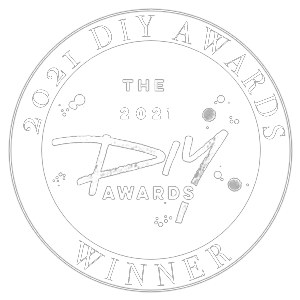Board and Batten For Under $100
Let’s build a board and batten wall! Board and batten walls are great beginner projects and are more simple than they may appear. First thing you’ll want to do is plan it out – How many vertical battens do you want? How many horizontal battens? What thickness of batten? Is you wall textured or smooth? Once you have these main things figured out, it’s time to get building!

Materials I used:
- mdf or wood in size of choice
- InstantBond Adhesive
- Brad nailer (optional)
- liquid nails (optional)
- wood filler
- sandpaper
- paintable caulk
- paint of choice
- Hardboard/backer board (if your walls are textured)(optional)
For my wall, I used 1/2 x 3.5 inch primed MDF trim. If you plan to use wood, always make sure to check that it isn’t warped. Another thing to note is, most wood will measure smaller than it is listed. Ex – If you are buying 4 inch pine, it might reassure 3.5 to 3.75 inches instead. Make sure to take this into account for your wall measurements. Before this, you’ll need to fill any holes using drywall sparkle and sand down smooth.

When figuring out how far apart your battens will be, take you wall length and divid it but the number of battens your want – don’t forget to count the “frame” or edge pieces. This website will help you figure that out. Do the same for the height of the wall. If you have textured walls and need to use backer board, you will have to place your battens in-line with the seams of the board.
Now because I didn’t have to prime the battens, I went ahead and primed the wall prior to attaching the battens so I didn’t have to work around them later. This is totally a preference but I find it easier.

Here comes the fun part – putting the battens in place. You want to do your verticals first. I find it best to start with taping them in place and checking to make sure they are straight and level. Once they are, make a pencil mark all the way down the batten. If you are using a nailer and the batten is not aligned with a stud, you’ll need to use liquid nails. I use a product was InstaBond – this is a two-part adhesive where I applied glue to batten and then used the spray between the pencil marks. This will require two people to apply as it sets in 3 seconds so you’ll need to make sure you have it perfectly lined up before applying pressure. Like liquid nails, the adhesive is permanent and will cause wall damage if removed so try to line up with studs if you can and use just a nailer.
Once the vertical battens are attached, begin measuring and cutting the horizontal ones to fit. Again, I used tape and a level to ensure they were aligned and straight. Apply with the same method used for verticals.

Filling the seams and caulking all the joints is next. You want to make sure you caulk all edges the meet the batten and the wall. Take wood filler or sparkle and fill in the face joints. You may need to do this twice is your filler shrinks a bit. Once dry, sand to a smooth finish using a drywall sanding block or 220+ grit sand paper.
For my wall, I went with Behr Ultra Pure White and my wall required 2 coats of paint. Once the paint it done, it’s finished! This wall cost me around $78. I had the paint and adhesive on hand but if I had to buy those, it would be around $100.










